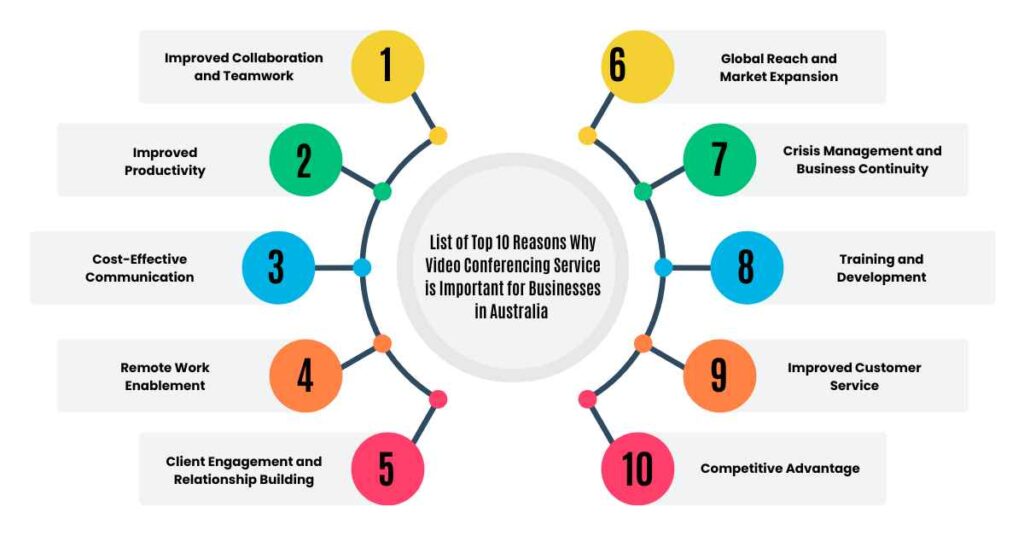In today’s high-speed, digital age, companies everywhere are turning toward innovations to facilitate ease of conducting business operations and to cooperate and increase productivity.
Video conferencing is one of the prominent tools Australian companies use to eradicate geographical constraints while conducting their business. Since these enable real-time, face-to-face conversations, they have revolutionized the face of running a business in every which way – communications with the clients and meetings alike.
List of Top 10 Reasons Why Video Conferencing Service is Important for Businesses in Australia

1. Improved Collaboration and Teamwork
Video conferencing allows teams to collaborate on any level, from one location or another. Fostering real-time interaction strengthens bonding between members, improves the communication of ideas, and accelerates decision-making processes.
2. Improved Productivity
Video conferencing eliminates the need for travel, significantly reducing the time and costs involved in business trips. Thus, teams can focus more on core tasks, and productivity and efficiency increase.
3. Cost-Effective Communication
Video conferencing is a cost-effective means of communication compared to making phone calls and holding meetings. In many cases, businesses can save significantly in costs related to traveling, besides cutting down the requirements of having physical office space.
4. Remote Work Enablement
The more widespread remote work becomes, video conferencing becomes the means for providing easy communication and collaboration between remote teams. Video conferencing creates a sense of unity and ensures that even far-off employees feel inextricably linked with the organization at large.
5. Client Engagement and Relationship Building
Video conferencing offers personalized and engaging ways of reaching clients. It helps businesses conduct virtual meetings, product demos, and client consultations that can strengthen relationships and create trust.
6. Global Reach and Market Expansion
Video conferencing allows global cooperation, which means that business organizations can reach clients and partners from all over the world. This opens new markets, opportunities, and international business relationships.
7. Crisis Management and Business Continuity
Video conferencing allows businesses to continue in times of crisis or unpredictable events, enabling them to communicate with stakeholders effectively and maintain business continuity while causing minimal disruption.
8. Training and Development
Video conferencing is the most appropriate tool for conducting training programs, workshops, and even webinars. This tool permits businesses to provide high-quality training to employees no matter where they are located.
9. Improved Customer Service
Video conferencing enables businesses to provide exceptional customer service by offering personalized support and addressing customer queries promptly. It enhances customer satisfaction and loyalty.
10. Competitive Advantage
Adopting video conferencing provides a business with an edge over competitors by simplifying operations, increasing efficiency, and enabling better customer service. They are portrayed as innovative and forward-thinking companies.
How ByteWay can elevate your Video Conferencing experience in Australia?

ByteWay is one of the best video conferencing solutions available in Australia. It has a wide-ranging set of features and benefits that suit businesses with diverse needs.
- Exceptional Audio and Video Quality: ByteWay emphasizes quality audio and video to make communication seamless and meetings as engaging as possible.
- Robust Security and Privacy: Advanced security measures to protect sensitive information and privacy enable businesses to have peace of mind.
- Scalable and Reliable: The architecture of ByteWay can take up business of any size or scope while ensuring smooth working even in peak traffic sessions.
- Smooth Integration: Integrate well with popular productivity apps and calendars to streamline workflow for collaboration and teamwork.
- Intuitive User Interface: This enables users to master the platform and make the most of their time through productive meetings.
- Excellent Customer Support: ByteWay is dedicated to providing top customer support to help users get through any queries or technical issues, ensuring a seamless experience.
Summary
Here is the summary of the blog titled “Top 10 Reasons Why Video Conferencing Service is Important for Businesses in Australia“
- Improved Collaboration and Teamwork
- Improved Productivity
- Cost-Effective Communication
- Remote Work Enablement
- Client Engagement and Relationship Building
- Global Reach and Market Expansion
- Crisis Management and Business Continuity
- Training and Development
- Improved Customer Service
- Competitive Advantage
Conclusion
Video conferencing is the new buzz for businesses in Australia, bringing along with it collaboration, productivity, and innovation. With a proper video conferencing service, like ByteWay, businesses can reach the ultimate benefits that video conferencing can offer.
Video conferencing will be an important component of modern business operations in the future because the digital landscape will always evolve.
FAQs
Q. What are the main benefits that video conferencing provides for businesses in Australia?
Ans. The main benefits that video conferencing provides for businesses in Australia are numerous including better collaboration, enhanced productivity, cost efficiency, remote work facilitation, client engagement, access to a global market, effective crisis management, and staff training and development for better customer service with a competitive advantage.
Q. What are the benefits of Video conferencing to small businesses?
Ans. Video conferencing can be beneficial to small businesses in Australia, it helps them compete with larger organizations. Video conferencing helps a small business in Australia in the following ways: video conferencing allows remote work; travel costs are reduced; and global connections are made.
Q. What are some of the security concerns around video conferencing, and how can they be addressed?
Ans. Some of the security concerns for video conferencing include unauthorized access and data breaches, which can be addressed by making sure to choose reputable providers of video conferencing with robust security measures, including encryption, password protection, and user authentication.
Q. How do I enhance the video conferencing quality?
Ans. Some tips to enhance your video conferencing experience include that you should have a reliable internet connection, using a high-quality webcam and microphone, choosing a well-lit environment, and eliminating as much background noise as possible.
Q. What are a few of the Video conferencing etiquette tips?
Ans. Video conferencing etiquette tips include arriving at the venue on time, dressing suitably, muting the microphone when not speaking, making sure to keep eye contact with the camera, and clearly and concisely presenting one’s ideas.
Q. How can Video conferencing be used in a remote team-building and cultural context?
Ans. Video conferencing can be used to organize virtual social events, team-building activities, and even organizing regular team meetings. Video conferencing helps in building a sense of community and belonging among remote team members.
Q. What are the future trends in video conferencing technology?
Ans. Future trends in video conferencing technology will include increased AI-powered features, automatic transcription, real-time translation, and virtual backgrounds, among others. More video conferencing software will incorporate other collaboration tools and offer enhanced virtual reality experiences.
Q. Can video conferencing replace in-person meetings altogether?
Ans. Video conferencing can never totally replace face-to-face meetings. There are many pros to video conferencing; however, it cannot do the work of face-to-face meetings, especially building close relationships and more complex negotiations, but can reduce travel and make communication better in general.
Q. How can I ensure that video conferencing is productive and engaging?
Ans. Making video conferencing productive and engaging requires the following: preparation with an agenda, ensuring active participation of participants, utilization of visual aids, keeping to the topic in discussion, providing breaks, and some socializing.




